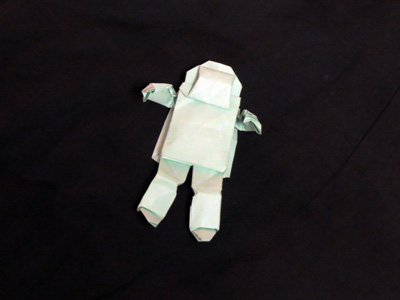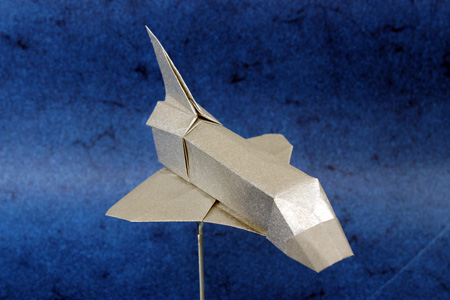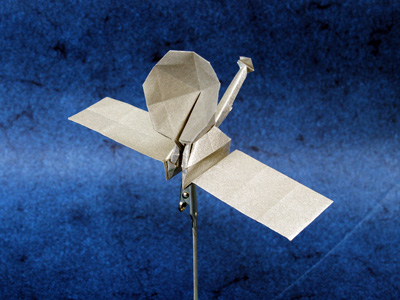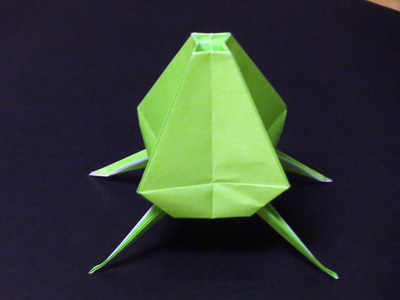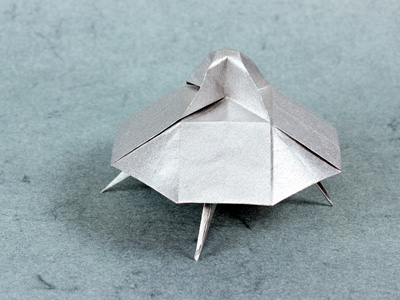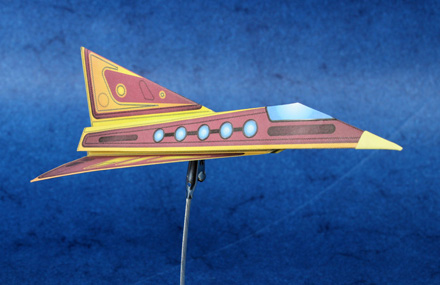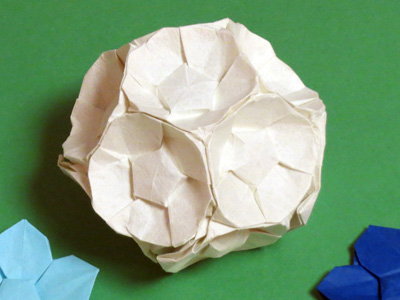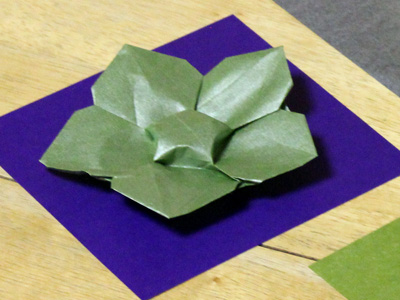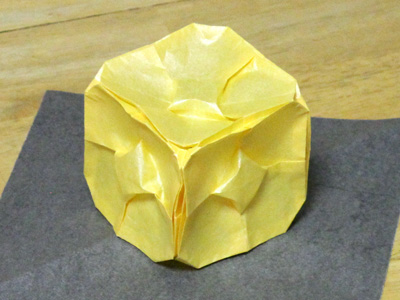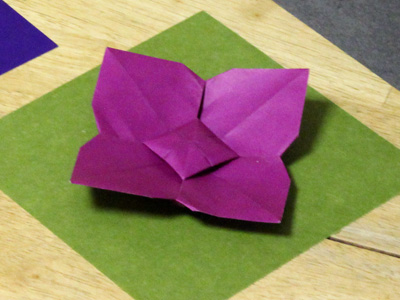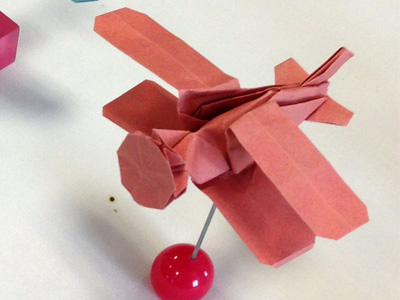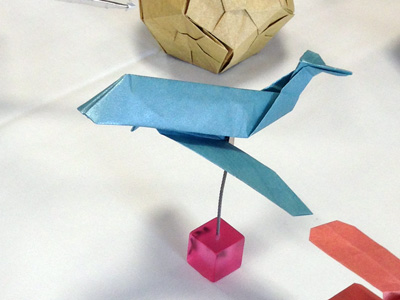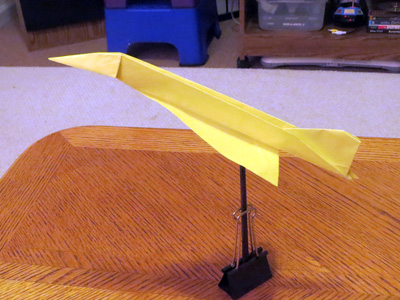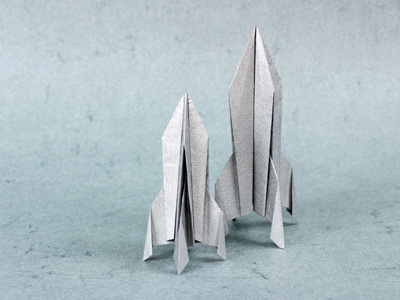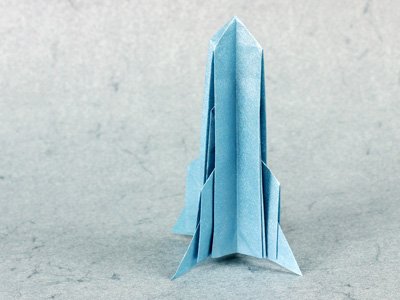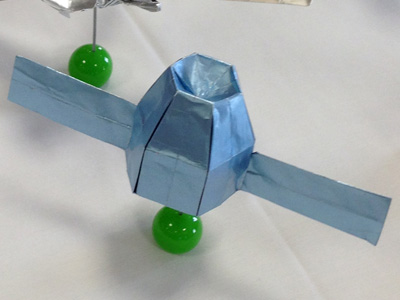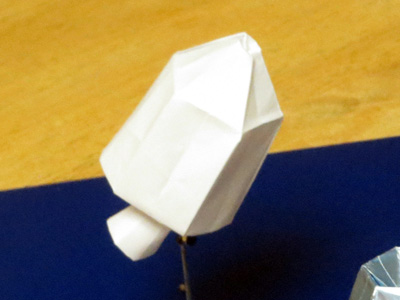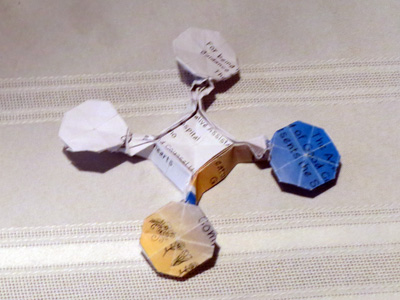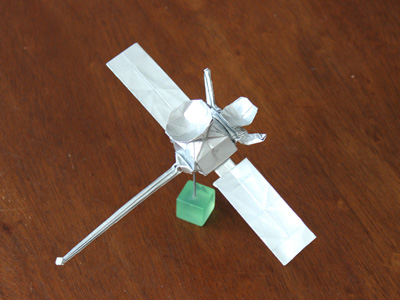Astronaut
2015
Based on a half-remembered box-pleated frog someone showed me once. The base, human or frog, has the limbs in the right place and the box-pleating technique results in limbs that don't taper, as with a traditional base. One nice detail is the spread-squash to form the visor. In focusing on simpler models I've been going back to alot of traditional moves, looking for new ways to use them and finding they can be really expressive.
Space Shuttle
2015
This model began as in improvised variation on the same general approach that yeilded the Jet Airliner, Supersonic Transport and Rocket Plane. It came out very nicely, with a fully 3-D form and a color change on the nose. From there it was just a matter of refining the proportions.
Space Probe
2015
A simplification of my Radio Satellite, down from 60 or more steps to 20 or so. It follows the same general pattern, with solar panels and a radar dish and a boom antenna, but with an 8×8 grid instead of 16×16 so the proportions are different. Instead of developing the radar dish from the center, which requires pulling out alot of layers, I use a corner. Look closely and you'll see a hidden crane, as the model passes thru a variation on the bird base.
Space Pod
2015
I've had a verion of this, just a doodle really, a simpe development of the frog base, sitting on the shelf by my piano for many years. One of my earliest succesful models, I've always found it cahrming. I finally decided to work out a proper design and folding sequence.
Flying Saucer
2015
I simplified model in the the vein of my U.F.O. The predecessor is about 50 steps and admittedly fairly difficult to fold, although certianly a popular model. The new Flying Saucer that uses traditional 22.5 degree geometry instead of 15 degrees, and has a much simpler way to develop the center dome. It's only 20 or steps, and takes about 10 mintues to fold instead of an hour.
After designing my Flying Saucer (U.F.O. II) and Retro Rocket (Rocektship III), I was on a roll, so I came up with this air and space craft, based on a plane I saw at Wright Patterson Air Force Base in the experimental hangar.
Inspired by various floral modular polyhedra, I set out to make a single sheet flower-ball. It is the 3-D evolution of the FiveFold Flower. Folded from a ~15" (35cm) sheet of "Grainy" paper I got the Brian Webb's Origami Shop. This turned out to be a great, high-performance paper for a demanding model. Very workable and holds its shape very well. I didn't have to wetfold the piece.
Fivefold Flower
2015
Setting out to make a single sheet flower-ball, I began with a simple pentagonal flower tessellation, which on it's own is a nice, low-intermediate model. You can fold a bunch of them and make an arrangement.
Flowercube
2015
The 3-D evolution of the Fourfold Flower forms the Flowercube.
Fourfold Flower
2015
A fourfold symmetrical version of the Fivefold Flower tessellation. Origianlly designed as a test to generate the Flowercube, it offers creative possibilities of its own.
Biplane
2015
Far less complex than other Biplanes out there, my Biplane is still on the complex side for my airplanes and spaceships. The form can be adapted into several other aircraft including a Seaplane, in which the lower wings become pontoons. It uses the same base as the Radio Satellite, with the propellor formed from the center of the paper.
Jet Airliner
2015
I wanted to make a realistic looking jet plane. Arriving at a rough plan was easy but alot of effort went into refining the proportions. I tried various combinations of engines, landing gear and other details, but in the end decided none of them were worth the added complexity and I went for a clean. streamlined look. At some point I might make an advanced version with detailed engines out of a different base. Itapos;d need a whole apos;nother flap the size of the wing.
Supersonic Transport
2015
A nice intermediate level model with good proportions and folding sequence. Perhaps this airplane's most famous flight was the one in 1985 that carried drummer and vocalist Phil Collins across the ocean to open the Live Aid concert in Wembley Stadium in London and close it RFK Stadium in North America sitting in with a (temporarily) reunited Led Zeppelin.
Retro Rocket
2015
This was one of the first designs I came up with when putting together models for an airplanes and spaceships themed book. I revised several months later and the proportions are much more satisfying.
Art Deco Rocket
2015
The thing about simplicity is that it's actually harder than complexity. My natural tendency as a folder is toward the complex. The major insight here was to make avoid the puffing-out phase, that is to make an X rather than and O when seen from above.
SpaceX Dragon
2015
Of all the hundreds of paper dragons out there, I'm pretty sure this is the only one of these.
Apollo CSM
2015
CSM stands for Command-Service Module. A half-century ago this craft took American astronauts to the moon and back. I designed this model at the at the same time as the Dragon. In real life the two vessels have the same diameter. These models will too, if you fold them out of the same size paper.
Quadrocoptor
2015
I made this out of the program at a concert I went to for my kids. Some of the acts weren't very good but I couldn't just get up and leave. Uses the same propeller concept as the Biplane, but four times.
Radio Satellite
2015
The first new model to kick off a long series of designs around airplanes and spaceships, with an eye towards writing a new book. This model is a bit unusual for me in the that it starts with a grid and uses some box-pleating, but it's appropriate to the subject. The base is similar to my War Elephant, in that it embeds a Hydrangea tessellation in the middle of the paper and proceeds from there.
